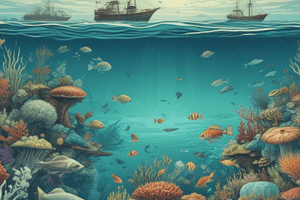Podcast
Questions and Answers
Which process is responsible for the storage of organic matter in the ocean?
Which process is responsible for the storage of organic matter in the ocean?
- Respiration
- Fermentation
- Photosynthesis
- Chemosynthesis (correct)
What percentage of the ocean's biomass relies on chemosynthesis for survival?
What percentage of the ocean's biomass relies on chemosynthesis for survival?
- 0.1% (correct)
- 10%
- 1%
- 50%
Which organisms perform photosynthesis in the ocean?
Which organisms perform photosynthesis in the ocean?
- Bacteria
- Fish
- Single-celled organisms (correct)
- Whales
Where are many of the bacteria that perform chemosynthesis found in the ocean?
Where are many of the bacteria that perform chemosynthesis found in the ocean?
What is the primary process responsible for storing energy or organic matter in organisms in the ocean?
What is the primary process responsible for storing energy or organic matter in organisms in the ocean?
Which layer of the ocean do single-celled organisms performing photosynthesis float in?
Which layer of the ocean do single-celled organisms performing photosynthesis float in?
What is the rate at which energy or organic matter is stored in organisms in the ocean called?
What is the rate at which energy or organic matter is stored in organisms in the ocean called?
What does chemosynthesis rely on for survival?
What does chemosynthesis rely on for survival?
Which process converts sunlight, water, and carbon dioxide into sugars?
Which process converts sunlight, water, and carbon dioxide into sugars?
Where is the majority of the ocean's biomass located?
Where is the majority of the ocean's biomass located?
Which process converts carbon dioxide, water, and sunlight into sugar and oxygen?
Which process converts carbon dioxide, water, and sunlight into sugar and oxygen?
What is the primary factor affecting primary productivity in the oceans?
What is the primary factor affecting primary productivity in the oceans?
What can excessive algal growth and reduced oxygen levels in the oceans be caused by?
What can excessive algal growth and reduced oxygen levels in the oceans be caused by?
Which type of seaweed is the most abundant and widespread?
Which type of seaweed is the most abundant and widespread?
Which type of algae is commonly found in freshwater and grows in intertidal waters or shallow bays?
Which type of algae is commonly found in freshwater and grows in intertidal waters or shallow bays?
Which type of marine algae are the largest members and range in color from light brown to black?
Which type of marine algae are the largest members and range in color from light brown to black?
Which type of golden algae produces food for 99% of all marine organisms and forms diatomaceous earth?
Which type of golden algae produces food for 99% of all marine organisms and forms diatomaceous earth?
What is the role of wind and trade winds in the oceans?
What is the role of wind and trade winds in the oceans?
Which phylum includes seed-bearing plants found in shallow coastal areas, providing food and protection for marine animals?
Which phylum includes seed-bearing plants found in shallow coastal areas, providing food and protection for marine animals?
What can satellite monitoring of ocean color indicate?
What can satellite monitoring of ocean color indicate?
Flashcards are hidden until you start studying
Study Notes
Factors Affecting Primary Productivity in the Oceans
-
9% of the ocean's biomass depends directly on photosynthetic organisms.
-
Primary producers, such as single-celled algae, hold up the entire marine life in the world's oceans.
-
Photosynthesis and respiration are cyclical and complementary processes that are fundamental on Earth.
-
Photosynthesis converts carbon dioxide, water, and sunlight into sugar and oxygen.
-
Phytoplankton, a type of primary producer, photosynthesize and create oxygen as a byproduct.
-
Nutrient availability, sunlight, and the Redfield ratio (C:N:P) are key factors affecting primary productivity.
-
Primary productivity can be measured directly using planktonic nets or by measuring radioactive carbon in seawater.
-
Satellite monitoring of ocean color can indicate areas of high primary productivity, with green indicating higher levels.
-
Nutrients needed for primary productivity are delivered to the oceans via runoff from rivers.
-
Runoff of fertilizers from farms can cause eutrophication, leading to excessive algal growth and reduced oxygen levels.
-
Solar radiation, especially blue wavelengths, penetrates the ocean surface and affects primary productivity.
-
Ocean margins are rich in life due to nutrient availability and sunlight, despite greater temperature and salinity variations.Types of Photosynthetic Marine Organisms
-
Wind and trade winds push surficial water, bringing nutrients and sunlight to the surface, leading to biological activity.
-
Phylum Anthophyta includes seed-bearing plants found in shallow coastal areas, like eelgrass and surf grass.
-
Anthophyta plants provide food and protection for marine animals in coastal environments.
-
Macroscopic algae, known as seaweeds, are found in shallow waters along ocean margins.
-
Seaweeds are classified based on pigment and can be green, red, or brown.
-
Green algae is common in freshwater and grows in intertidal waters or shallow bays.
-
Red algae is the most abundant and widespread macroscopic algae, often attached to the sea floor.
-
Red algae are adapted to receive less sunlight in deeper waters and can grow as deep as 100 meters.
-
Brown algae, or seaweeds, are the largest members of marine algae and range in color from light brown to black.
-
Brown algae are found in mid-latitudes and colder waters.
-
Diatoms, a type of golden algae, produce food for 99% of all marine organisms and their shells become diatomaceous earth.
-
Dinoflagellates are plankton that possess flagella for locomotion and have cellulose tests.
Studying That Suits You
Use AI to generate personalized quizzes and flashcards to suit your learning preferences.




